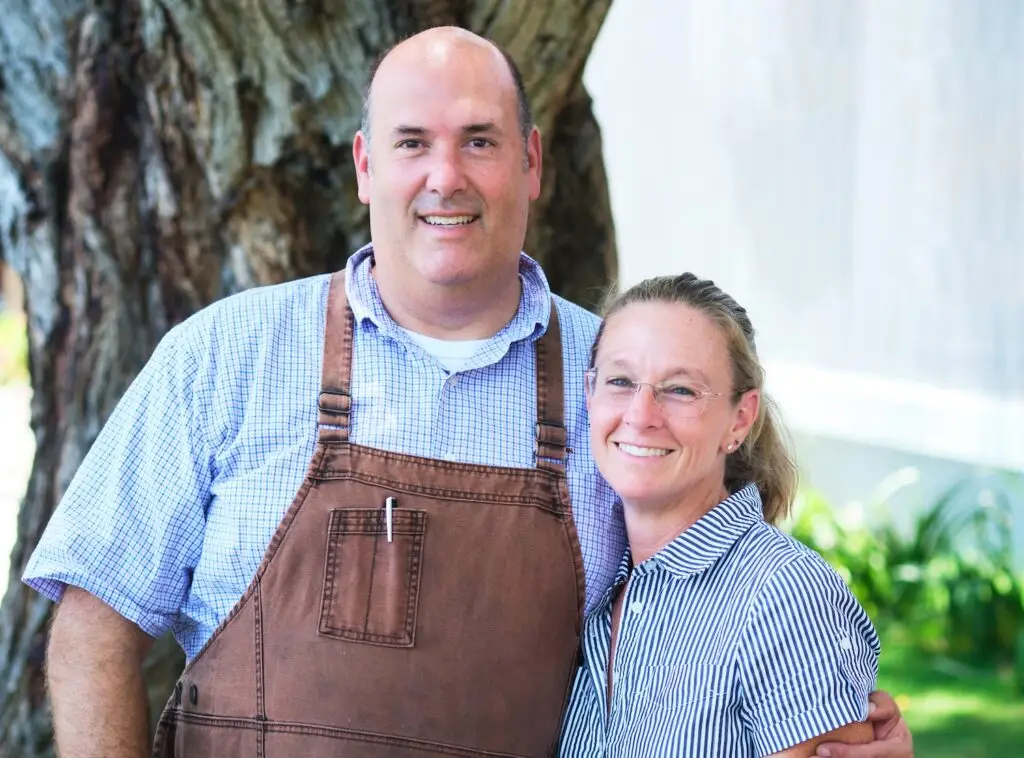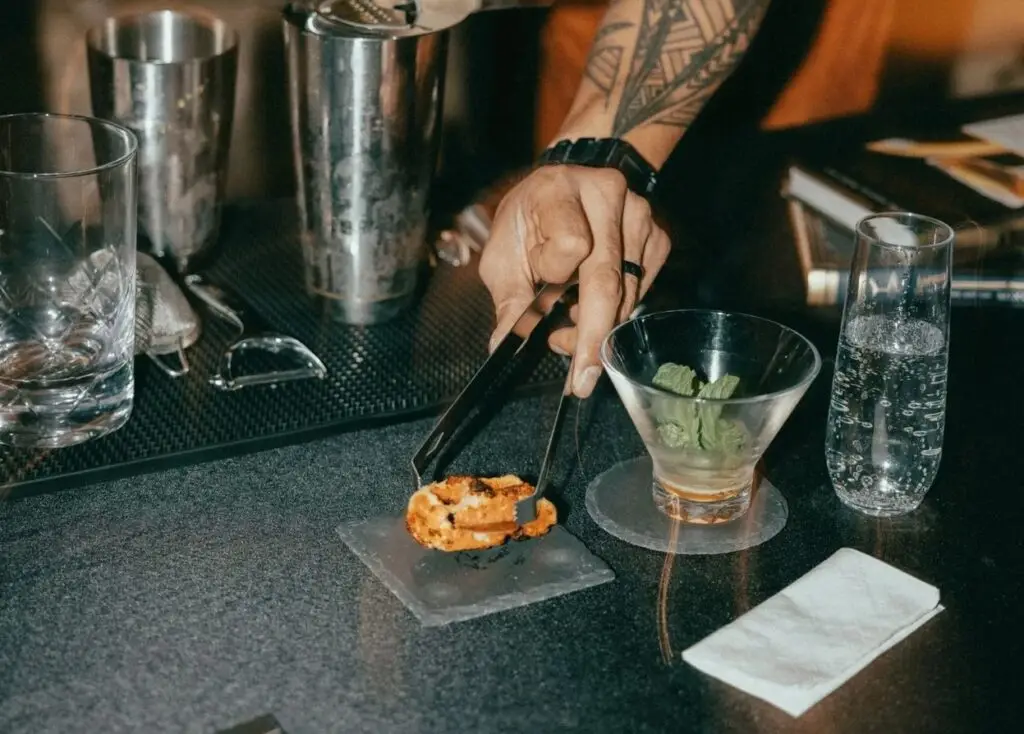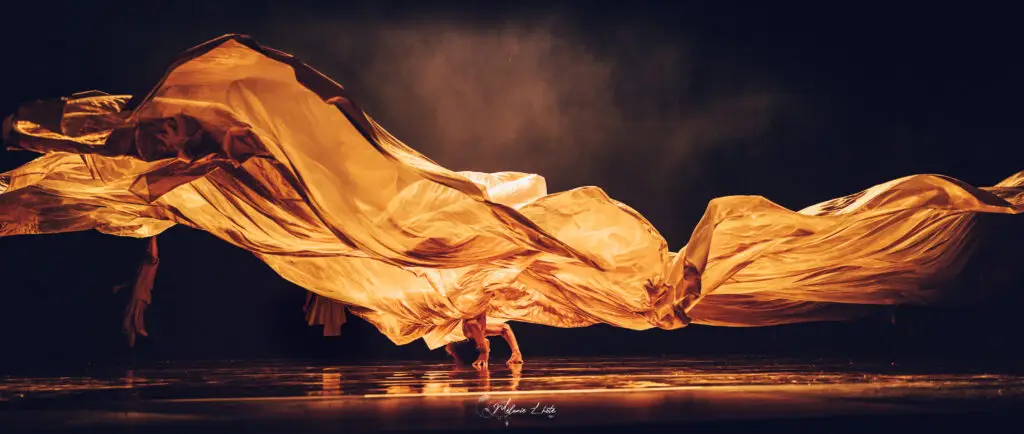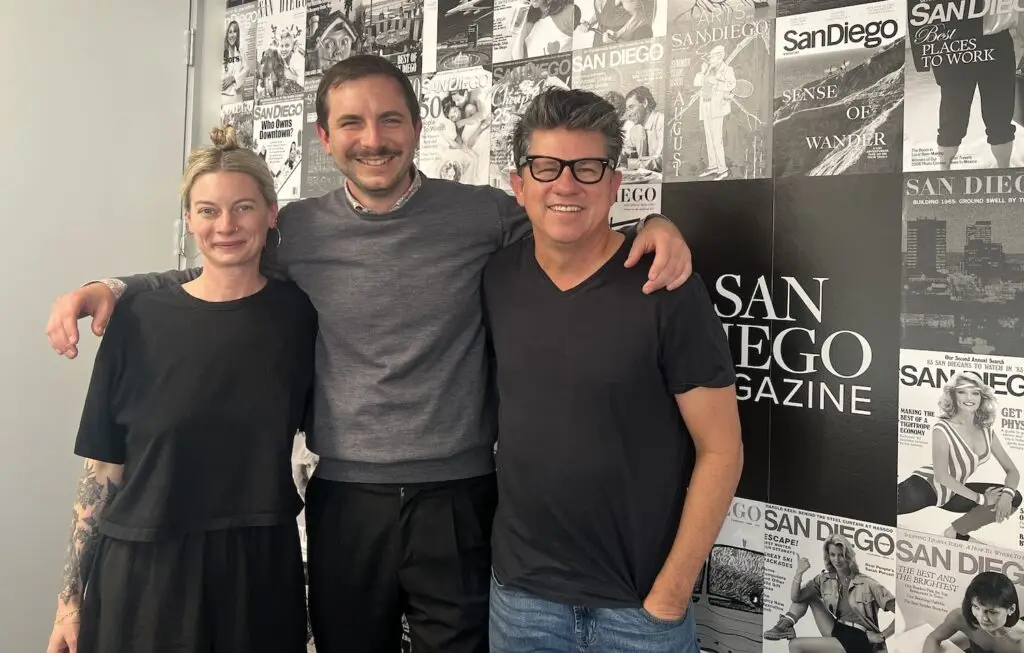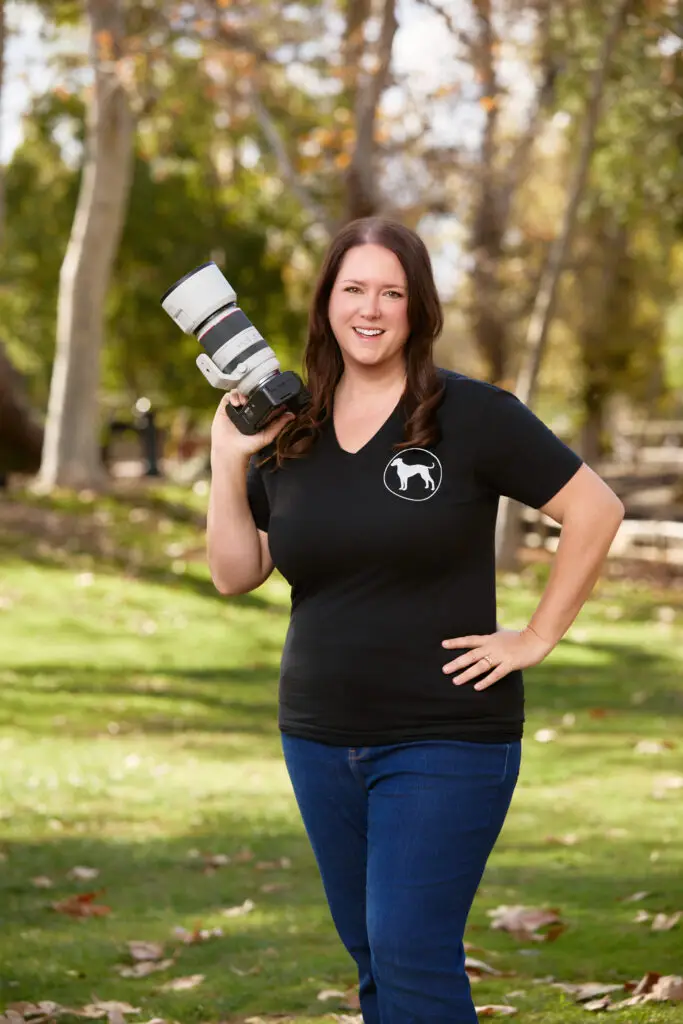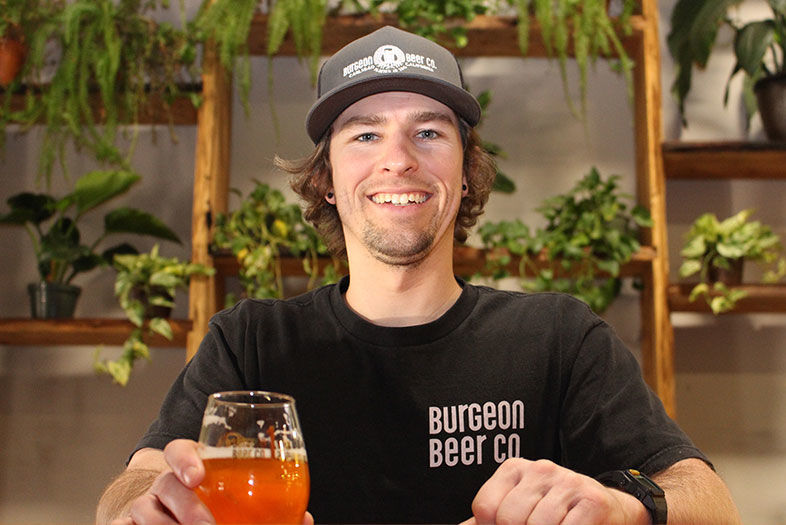At Burgeon—true to its name and concept—everything seems to blossom into something nice. The guys who founded the brewery (Matthew Zirpolo, Derek van Leeuwen, and Anthony Tallman) have been buddies for a long time. Born and raised in Carlsbad, these locals shared a love for beer that grew into a successful business partnership, one that emphasizes the fact that both their brewery and their beer are, as they like to say, “rooted in the local community.”
During the past year, Burgeon’s business and reputation have also blossomed. Not only have they built a solid fan base of tasting room regulars, they have won numerous awards (including gold medals from both the California State Fair and the San Diego International Beer Competition) and established themselves with many of the city’s most prestigious draft accounts as a brewery that does everything well. With fierce competition for tap handles and space at beer bars, this accomplishment is no easy feat.
All set up with a pint of Can’t Stop Juicin’ (one of Burgeon’s many super-tasty New England style IPAs) I sat down with Anthony Tallman to hear his thoughts on their first year in business, what the mission of the company continues to be, and how it feels to be one of San Diego’s new-brew success stories.
Here we are, just past your one-year anniversary. What are your most lasting impressions from the past twelve months?
It’s nice to get over the anniversary hump! I feel like the support we’ve gotten from local businesses and neighborhoods has been—well, it’s been more than what we expected or anticipated.
Do you get a lot of locals who live in the area as opposed to business folks?
I’d say it’s a good mix. We’re open seven days a week, so during the week it’s definitely the after-work crowd. And there are lots of those people who will consistently come in a couple of times a week. Some people come in every day. On the weekends it tends to be more family and friends, people having small parties in here. We haven’t been overly inundated with brewery tours, which can be a good and a bad thing, depending on where you are in the order of stops on the tour. It doesn’t always work out to your favor. We get Scavenger, and Beer Brewery Tours comes by once in a while—they’re great about giving us a heads up and their groups are always pretty small. They also try to plan it so we’re a stop early on, which we appreciate. I just think in general, over this past year, the support we’ve received—not only from draft accounts, but also in house—the support’s been amazing. We had a Keep the Pint Night at Stone recently and, when I walked in, there were four of our regulars from here sitting at the bar in Escondido!
So there’s a lot of loyalty?
There’s a lot of loyalty! I think we were fortunate enough to be producing some pretty good beer early on, which made it easier for people to feel like they wanted to come here and also come back, which is what our goal is.
What do your fans and regulars tell you they love about Burgeon the most?
Well, one thing Matt, Derek, and I wanted to do from the beginning was to always keep something new going on. I feel like the old trend where someone would go out and have one or two pints of their favorite beer each time has diminished over the last several years. There’s a lot of new craft beer drinkers and there’s so much variety and I think the mindset now is that people really go out looking for what’s new or cool or unique and different. So we try to stay true to a few beers that we’ve produced over this past year, but more often than not, we’re brewing new beers on a consistent basis. And I think that’s exciting for both our loyal customers and our new customers.
I’ve heard a lot of breweries say recently that it’s been a challenge finding venues where they can consistently have one or two tap handles on a regular basis, which used to be more common. Now bars are looking to rotate everything and always bring in new stuff. Do you feel that dynamic? That you’re constantly chasing the rotating handles?
It’s a little of both. We definitely have some accounts that stick to that one brand that we produce and want to keep that consistent. I would say that, percentage-wise, we’re pretty heavy with accounts that will pretty much take anything and everything from us, which is great. It fits our model of wanting to create new beers all the time and it fits their model of hyper rotation. So it keeps it fun for me because I’m getting to do new stuff all the time, even if there are those three, four, or five beers we brew consistently. What was important to us in the beginning, getting into places like Churchill’s and Toronado and Blind Lady and Hamilton’s and Regal Seagull, we had to send them some really good beer right off the bat and build the loyalty with them as a draft account, but hopefully you get to the point where they’re going to take whatever you offer them, even if they don’t know anything about the beer. That’s fortunately been the way it’s worked out for us.
You guys do a couple of very cool, lesser-done styles like grisette, but do you feel you’re basically known for doing hoppy beers?
I would say that probably by far we’re best known for hoppy stuff.
But you have from the beginning done a bunch of those more offbeat styles.
And that goes back to the beginning when the three of us discussed how we want our beer portfolio to pan out. We want to have a good variety. It’s fine if we’re known for making great hoppy beers—my goal would be to be known for just making good beer, period—and I would say right now is the most diverse we’ve been to date. We’ve got pilsner, oatmeal porter, a bunch of different IPAs—whether they’re West Coast or Northeast style—we’ve got our Berliner on, a pale ale, two big imperial stouts, we have our nut brown, so we’re pretty diversified right now and that’s the ideal situation for me.
What’s your bestseller at this point?
Definitely Treevana IPA. It’s our core West Coast IPA, with Mosaic and Amarillo hops. It just has a great profile on it. That’s just about the only IPA that, if somebody wants a permanent IPA handle from us, we can offer. We do have quite a few permanent handles for that beer, and it’s probably the top seller here in the tap room on a consistent basis.
What are the new types of beers you’re doing?
The Berliner we have on with mango and the one we’re fruiting now with strawberry purée are the first two beers we’ve ever used fruit on. So we’ll see how that goes. The first Berliner went available to draft accounts a few weeks ago and it sold really well.
I know from talking with bar owners and managers that, for a lot of customers, they look at a tap list and if there’s fruit in anything, it just disappears.
Yeah. We’re not personally big fans of the fruited IPA thing, I don’t know if we’ll venture into that, but the Berliner we have on now is the first one we’ve ever brewed and I’m pretty happy with the way it turned out. I’m hoping we can carve out a little niche for ourselves so we can keep some kind of Berliner in rotation.
You said you just brewed your first Berliner. What was your brewing background before starting Burgeon? Did you come directly from Stone?
Well, I jumped around a little bit. I started at Stone in 2010; that was my first brewery job. I only had homebrew experience at the time. I applied multiple times until I finally got an interview and got my foot in the door. I worked at Stone for about two years, and then I left and had the opportunity to be the first brewer for Rough Draft Brewing Company, and I was there for about a year and a half before I went back to Stone for a year. I went back with the intention of actually staying there and growing into some different positions, possibly getting more into their small batch program, but that’s also when the conversation about this project began. When the feasibility of this became real, I was able to jump over to Backstreet Brewery in Vista because my good friend Chris Gort, who was the brewer there, was leaving to start his own brewery and that was the ideal next path for me in order to make this happen. I was at Backstreet for about two and a half years, basically throughout the whole planning and fundraising for Burgeon. We got keys for this place on August 1 last year and I think I left Backstreet by about mid-September. I was juggling both for a while but it just became unrealistic.
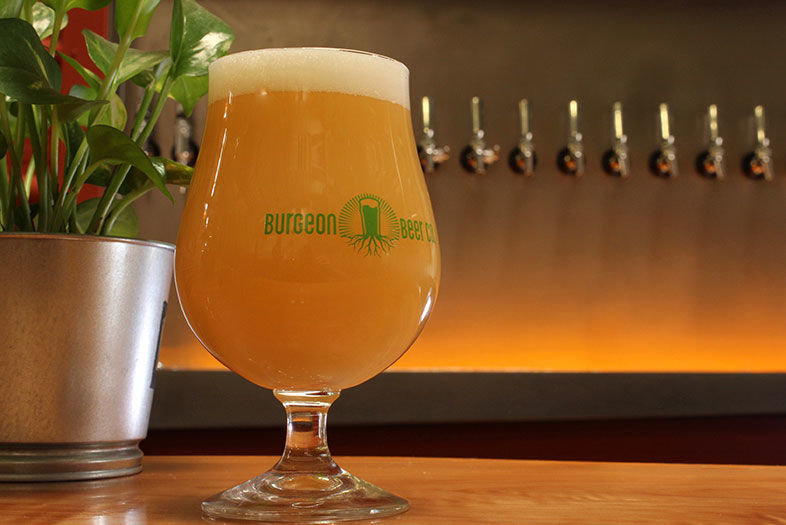
Have a Beer with Burgeon Head Brewer Anthony Tallman
Can’t Stop Juicin’ is one of the brewery’s hazy Northeast-style IPAs. | Photo: Bruce Glassman
What would you say was the most valuable piece of your Backstreet experience?
I had the freedom to brew whatever I wanted there, so it was a lot of testing of ingredients. I got lucky. At the time when I took over, they were opening a second production facility and they were going to brew the three or four core beers that they wanted to see on tap there. So I didn’t have to do any of that, which was great. I could really do anything I wanted to. So it allowed me to test out malts or hop combinations, new hop varieties. It was a little more of an experimental route for me, as far as brewing went. But I was also able to do more than I had done at Stone—I was ordering raw materials and handling the inventory and working with suppliers. Those were valuable things I just wouldn’t have had the opportunity to do at Stone.
What was the most valuable thing you came away with from your Stone experience?
It allowed me to be a part of a company that was constantly evolving and growing at a very fast pace. And the expansions meant they brought on brewers to work on new projects as well, like the new packaging hall, and there were a lot of meetings they let us be a part of to help design pipework and manifolds and things like that—stuff you wouldn’t necessarily get to be a part of at another brewery. The great thing about working at Stone was that you were always working with a team of guys, and that’s a valuable lesson. Learning how to work cohesively with others. I don’t miss that large of a scale of brewing, but it was one hundred percent what helped me get to where I am and I’m forever thankful for it.
What sticks out in your mind from the past year that surprised you or you’re especially proud of?
I think the unexpected rate of growth we had this year has been one of the more difficult things for us. It’s been amazing, but trying to wrap your head around it and make sure we’re making the right decisions has been a major challenge.
Would you say growth has been twice as fast as you had anticipated?
I don’t remember what we had projected in terms of when we were going to add tanks and what sizes, but we started with 105 barrels of fermentation space and in the first year we added another 120. We projected we were going to produce 900 barrels the first year and we produced 1,700. So it was a little overwhelming at times! But we were able to bring in the right people who allowed us to manage that expansion, so that was the key.
Major goals for the coming year?
We’d love to get a satellite tap room going, not certain on the area. And a second goal is to continue to increase our canning and getting it to the point where we can justify buying our own line. I’d love to get a canning line in here. Those are our two big projects for this year. And we also want to continue doing collaborations a lot which we did this year.
Are there collaborations that stand out as your favorites?
We had a great time when we went up to Sacramento and brewed with New Glory. They’ll be down here in March to do a collaboration with us.
What was the beer you did with them?
We did a double IPA with them. They’re kind of similar to us in the kinds of beer styles they do and what they’re most known for.
Are there other beers that stand out in your mind from the past year?
One of our anniversary beers, called Glazed, was an Imperial Stout with more of that East Coast style—really viscous on the mouthfeel—we wound up doing two varieties of it, a toasted coconut, coffee, and cacao nibs, and we actually added donuts to it, from V.G. Donuts in Cardiff.
You physically added donuts to the beer?
Yes. We physically added donuts to it. So it’s truly a “pastry stout.” We added the donuts to the mash tun!
Is that…er…a common technique?
I know breweries have done it. I don’t think anybody in this area has done it, not that we know of. One of our workers, his girlfriend is a cake decorator for V.G. and when she brought the idea up to the owner he said, “They want to do what?” His mind was blown.
So, in the mash tun, it breaks down into a glop. And then…?
It was actually interesting. It literally tasted like nothing after the mash. And it didn’t seem to have too much of an effect on the gravity of the wort—I was thinking all the sugar in the donuts would really bump the gravity, but it didn’t have too much of an effect on it. We did a four-and-a-half-hour boil, where a lot of viscosity and mouthfeel came from. Turned out to be a great beer! We bottled it before the anniversary and sold out of it the day after. It’s been pretty well-received so I think we’re going to continue to toy around with that concept.
Author’s note: I had a chance to get a taste of Glazed at the tasting room and it is a truly unique and delicious beer. Tastes like you’re drinking a stout from a box of freshly baked donuts. If you see it, don’t miss it!
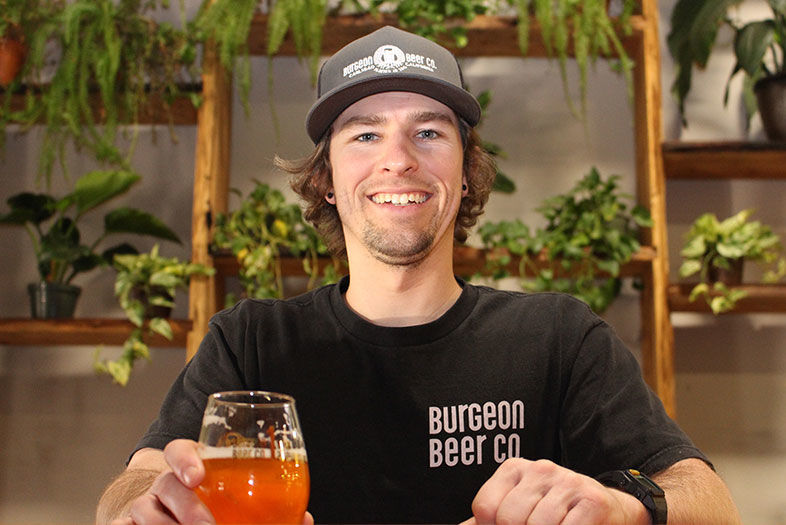
Have a Beer with Burgeon Head Brewer Anthony Tallman
PARTNER CONTENT
Burgeon’s Head Brewer Anthony Tallman | Photo: Bruce Glassman
